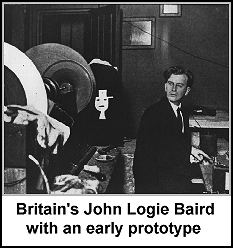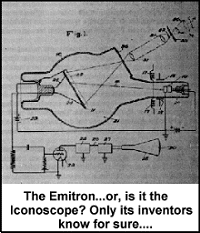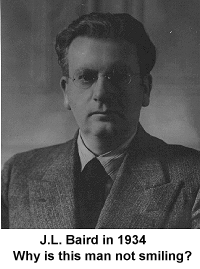
Part 8: "We want CASH!"
by Paul Schatzkin
In the dark and starry nights he spent on the deck of the S.S.
Bremen, Philo T. Farnsworth, now 28 years old, had ample time
to reflect upon the unlikely chain of events that found him sailing
on a luxury liner enroute from New York to London.
By the fall of 1934 Philo's daring invention of electronic television
should have placed him at the vanguard of the new emerging communications
industry. However, RCA, world's largest radio manufacturing and
broadcasting concern, was committing time and vast sums of money
to fight tiny Farnsworth TV over the patents which were the foundation
for the commercialization of television. But for Philo, his "lab
gang," and the scattering of patient investors he had attracted
over the years, the litigation with RCA had a twin edged effect.
As long as Farnsworth's patents remained under contention, his
company could neither sell licenses nor collect royalties on the
inventions he had discovered. Without these funds, Farnsworth
was hard-pressed to maintain his legal defenses.
Pressure was building from some backers who would have had Farnsworth
accept RCA chief David Sarnoff's one-sided terms, which amounted
to a total sell-out of the inventions to RCA. Consequently, investment
money that could have been used to begin new areas of scientific
inquiry was diverted into the ongoing legal battles.
Nevertheless, Farnsworth knew that his portfolio contained many
patents that were unavoidably fundamental to the art of turning
light into electricity by means of a pencil-thin, rapidly deflected
electron beam. Subsequent developments by other companies, like
RCA, proved that this was indeed the direction that the rest of
the industry would follow. But owning the patents alone was not
sufficient to guarantee Farnsworth's ultimate prosperity.
Since domestic markets were forestalled indefinitely by the cloud
of litigation, Farnsworth had no choice but to seek foreign alternatives
for money. When Baird Television of England invited him to bring
his invention to England, to be considered for a patent license
there, Farnsworth was certain that he had found a timely solution
to his costly delays at home.
 Baird Television was named for John Logie Baird, an inventor of Scottish descent
whose mechanically-scanned television device made him the first independent
inventor to earn any money from sending pictures through the air. This was
possible in part because broadcasting in Britain was almost entirely controlled
by the government sponsored British Broadcasting Corporation. During the early
1930's the BBC permitted Baird to use their radio channels at night to broadcast
pictures on a temporary, experimental basis. Using one radio channel for his
low-frequency, low-resolution pictures, and another channel for sound, Baird
managed to sell several thousand "televisor" receivers in kit form
throughout Europe. The radio amateurs who assembled these kits were rewarded
for their diligence with a fuzzy preview of the age old dream of seeing from
a distance.
Baird Television was named for John Logie Baird, an inventor of Scottish descent
whose mechanically-scanned television device made him the first independent
inventor to earn any money from sending pictures through the air. This was
possible in part because broadcasting in Britain was almost entirely controlled
by the government sponsored British Broadcasting Corporation. During the early
1930's the BBC permitted Baird to use their radio channels at night to broadcast
pictures on a temporary, experimental basis. Using one radio channel for his
low-frequency, low-resolution pictures, and another channel for sound, Baird
managed to sell several thousand "televisor" receivers in kit form
throughout Europe. The radio amateurs who assembled these kits were rewarded
for their diligence with a fuzzy preview of the age old dream of seeing from
a distance.
Unfortunately for Baird, the costs of tooling up for production
forced him to seek financial assistance and in the process he
lost control of his company to a large conglomerate called British Gaumont. This arrangement worked fine for Baird until 1934, when the BBC expressed dissatisfaction
with Baird's system and invited him to conclude his experiments.
This development came as quite a surprise to Baird's backers,
and they urged him to develop an electronic television system
in order to stay competitive.
Baird was steadfast in support of his own invention, but the Directors
of British Gaumont were not about to let a potentially lucrative
business slip through their fingers. So British Gaumont ignored
the objections of the inventor in whose name they acted, and compelled
John Logie Baird to seek a license from a young American inventor
named Philo T. Farnsworth.
The shift in Baird's fortunes began some time in 1933 when scientists
at the EMI Corporation in London demonstrated the rudimentary
capabilities of an electronic television system to the BBC brass.
The receiving end of this system was a familiar cathode ray tube;
the camera tube, which EMI modestly dubbed the "Emitron"
is a much more intriguing development.
 What was curious about the Emitron tube was its unmistakable resemblance to
another device, the RCA Iconoscope, which Vladimir Zworykin had first demonstrated
for RCA during the same period. Both tubes employed the same one-sided photocathode
composed of discrete photoelectric islands, and an unusual triangular scanning
configuration. There is no question that the Emitron and the Iconoscope were
virtually identical devices. The only question that stands unanswered is "which
laboratory produced it first?"
What was curious about the Emitron tube was its unmistakable resemblance to
another device, the RCA Iconoscope, which Vladimir Zworykin had first demonstrated
for RCA during the same period. Both tubes employed the same one-sided photocathode
composed of discrete photoelectric islands, and an unusual triangular scanning
configuration. There is no question that the Emitron and the Iconoscope were
virtually identical devices. The only question that stands unanswered is "which
laboratory produced it first?"
J. D. McGee, one of the EMI scientists who developed the Emitron, when interviewed in London in the spring of 21976 London, insisted
that it is possible for the same scientific development to occur
simultaneously in different places because there is frequently
only one viable solution to a problem. However, there is evidence
to suggest that RCA enjoyed a long-standing, mutual cross-license
arrangement with EMI in which these two giants shared their information
and patents.
In other words, in the fall of 1934, as Farnsworth sailed for
Europe hoping to form an alliance that would enable him to overcome
his difficulties at home, his principal domestic adversaries were
already operating a trans-Atlantic alliance of their own.
Of course, Farnsworth had no knowledge of all these backstage
dealings. As his boat arrived in Southampton, he was unaware that
the struggle to bring television to Europe would be drawn along
exactly the same lines as his struggle in America.
Success at Last
The ship that carried Farnsworth and his precious cargo arrived
in Southampton in the fall of 1934. Farnsworth was accompanied
by two laboratory assistants, Tobe Rutherford and Arch Brolly,
and Skee Turner, who was on board to assist Farnsworth in the
negotiations for a patent license.
While Farnsworth and Turner went off to meet their hosts from
Baird, Tobe and Arch stayed on the ship to keep an eye on the
equipment as it was unloaded from the cargo hold. This turned
into an unexpectedly tricky maneuver, because a British maritime
labor dispute prevented the Bremen from unloading directly onto
the British dock because it was a German ship. Consequently, all
the cargo had to be transferred to a smaller, British vessel,
before it could be unloaded onto the dock. Gusty winds and choppy
water caused the crate holding Farnsworth's irreplaceable equipment
to sway precariously as it was hoisted out of the hull of the
Bremen.
Tobe and Arch held their breath as the crane swung out over the
edge of the big ship and the crate began a controlled descent
toward the bobbing deck of the smaller ship. The crate was only
inches from a safe landing when a sudden wave caught the smaller
ship; instead of the crate being lowered gently to the deck, the
deck rushed up to meet the crate, smacking it with a force equivalent
to a fall from several feet.
Farnsworth and his men were unable to assess the damage until
several hours later, when the crate was unsealed at Baird headquarters
in London. John Logie Baird stayed alone in his office, but his
representative hovered about restlessly while Phil and Tobe lifted
the lid. The sudden change in their expressions when they peered
into the crate was a dead giveaway that things inside looked grim.
Indeed, three racks of electronics had sheered away from their
mountings and fallen into a heap at the bottom of the crate. Baird's
men smiled to each other when they saw the mess for themselves
-now they could report to their boss that the American machine
was wrecked.
Less than an hour later, Baird's cause for celebration was interrupted.
Skee Turner appeared at the door, inviting Baird and his men to
come back downstairs for their first look at electronic television.
The Baird contingent followed Turner, accompanied now by representatives
of British Gaumont.
Farnsworth had placed both the camera and the receiver near the
door, and the instant the British Gaumont people entered the room
they were confronted by their own disembodied image, rendered
in stunning clarity and detail.
 The Britons were startled by the experience. After years of financing Baird's
mechanical television system, the most resolution that the British Gaumont
people ever saw was 60 lines per frame. Now they were confronted with an image
composed of more than 300 lines per frame, rendering detail they had always
been assured was quite impossible. Confronted by Farnsworth's obvious accomplishment
to the contrary, the British Gaumont people realized that they'd bet on the
wrong horse.
The Britons were startled by the experience. After years of financing Baird's
mechanical television system, the most resolution that the British Gaumont
people ever saw was 60 lines per frame. Now they were confronted with an image
composed of more than 300 lines per frame, rendering detail they had always
been assured was quite impossible. Confronted by Farnsworth's obvious accomplishment
to the contrary, the British Gaumont people realized that they'd bet on the
wrong horse.
The stunning effect of this demonstration did little to ease the
shock of Farnsworth's terms when they were finally presented.
The Board of Directors of British Gaumont sat in bemused tolerance
while Farnsworth explained that in addition to the customary continuing
royalties, he wanted a $50,000 down payment to act company the
license, as a sort of opening fee, a royalties-in-advance payment.
 What British Gaumont had envisioned was more like a mutual exchange, a sort
of our-patents-for-yours proposition, with no cash involved. But actually,
Farnsworth couldn't think of anything in the British Gaumont patent portfolio
that he really needed, certainly none of John Logie Baird's patents. It seemed
to Farnsworth that he was the only one holding any cards in this game, and
he stood firm: $50,000 cash or no license. The negotiations quickly bogged
down.
What British Gaumont had envisioned was more like a mutual exchange, a sort
of our-patents-for-yours proposition, with no cash involved. But actually,
Farnsworth couldn't think of anything in the British Gaumont patent portfolio
that he really needed, certainly none of John Logie Baird's patents. It seemed
to Farnsworth that he was the only one holding any cards in this game, and
he stood firm: $50,000 cash or no license. The negotiations quickly bogged
down.
Farnsworth asked for a short recess to confer privately with his
associate Skee Turner. Once alone, they hardly needed to speak;
the determined looks in their eyes was mutual. They would not
go home empty-handed.
Skee Turner was first to notice a bottle of Scotch and one small
glass standing on a mantle, and with a compulsive, defiant flourish,
he poured himself a shot and choked it down. Turner then handed
the bottle and glass to Farnsworth, who hesitantly did the same.
Taking a brief moment to recompose themselves, Farnsworth and
Turner returned to make their final stand before the British Gaumont
Board of Directors.
It's not hard to envision the subsequent encounter: The spokesman
for British Gaumont leans forward, confident that these young,
inexperienced bargainers were about to propose a clever Yankee
"compromise". Instead, Farnsworth firmly reiterated
his earlier terms: "We want cash," he declared,
speaking now with a tone of finality in his voice, assuring the
Board of Directors that the negotiations were about to conclude,
one way or another.
The Board of Directors stiffened in surprise, mumbled among themselves
for a few moments, and then conceded to Farnsworth's demand.
Premonitions of the Shipping Room Door
Exciting as their cruise across the Atlantic to Britain must have
been, the return voyage with $50,000 in their pocket must have
been truly exhilarating for Farnsworth and Company. That sum represented
the first genuine reward for nearly 10 years of concentrated effort.
 Motivated by such sudden success, Farnsworth and Skee Turner spent
the entire week at sea daydreaming about ways to parlay their
windfall into even greater success.
Motivated by such sudden success, Farnsworth and Skee Turner spent
the entire week at sea daydreaming about ways to parlay their
windfall into even greater success.
The first public demonstration of Farnsworth TV had been a few
months earlier at Philadelphia's Franklin Institute, where thousands
lined up to see the new electronic marvel. The next step, Philo
and Skee decided, was to demonstrate the day-to -day operation
of television broadcasting, something which could be done immediately
by investing the British license fee into a fully equipped television
studio that could sustain a regular schedule of experimental broadcasts.
However, the $50,000 license fee was not entirely Farnsworth's
property. The money, as well as all of Farnsworth's patents were
actually the property of Television Limited, the holding company
that Jess McCargar formed to raise money when Farnsworth had walked
out of the Philco Radio Company back in 1933. Farnsworth still
owned a significant portion of the equity in the enterprise, but
he was by no means the majority stock holder.
Instead, the numerous investors who had acquired chunks of stock
were represented by their own Board of Directors, and that august
body, not Farnsworth would determine the disposition of the Baird
license fee.
Farnsworth realized how the power in his life had shifted almost
the moment he stepped off the gangplank: Jess McCargar demanded
that the $50,000 be forwarded immediately to the business offices
in San Francisco, and that the matter of building a studio be
tabled until the Board of Directors could consider it. In the
meantime, Jess figured that $50,000 would serve nicely to pay
off some old bills, for example, the $30,000 tab for legal services
contracted during the patent litigation with RCA.
Farnsworth and Turner saw their dream of a studio facility that
would give them an entry into the lucrative broadcasting business
dissolve in the face of McCargar's singlemindedness.
What Farnsworth feared was that his sponsors would choose to take
the conventional approach, and attempt to secure the future of
Farnsworth Television by doing what Farnsworth called "tacking
on the shipping room door," i.e. following in the pattern
established by giants like RCA and opening their own factory to
build and sell merchandise.
Farnsworth felt that a more lucrative future could be found in
the field of television broadcasting, as radio broadcasting had
already proven to be massively profitable. Building a studio facility
seemed like a logical step in this direction; in his dreams, Farnsworth
would let others worry about the manufacturing. His company would
collect royalties for the use of his patents, and that revenue
would free Farnsworth to devote his own energy to new lines of
research, to explore the curiosities that appeared in his observations
every day.
However, this issue never really surfaced when confrontations
began to erupt with Jess McCargar. For his own part, Jess was
only questioning the wisdom of taking on another sizable expense
when they could hardly meet current expenses. But when the Board
of Directors sided with McCargar, Farnsworth realized that the
odds were no longer in his favor. As much as he hated to admit
it, this denial of a studio left Farnsworth numb with the realization
that not unlike John Logie Baird, he had lost control of his destiny
to men who would not always share his vision.
End of Part 8
Continue with:
Part 9: "You're All
Fired!"
This story is brought to you
as a public service by:
| 49chevy.com |
� 1977, 2001Paul Schatzkin; All Rights Reserved
For more information contact: The Perfesser
|